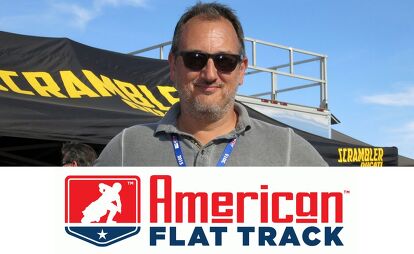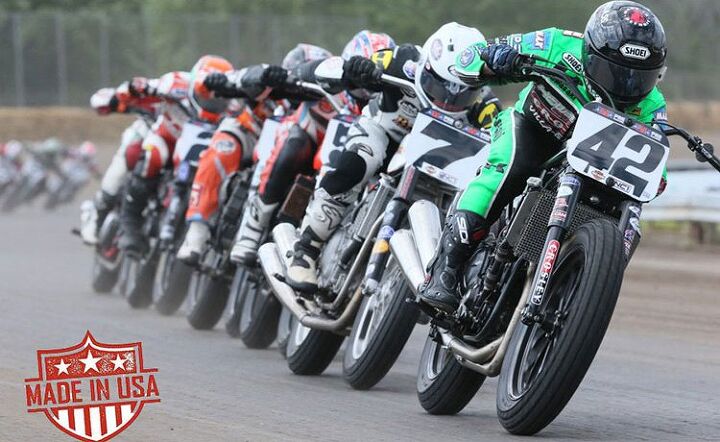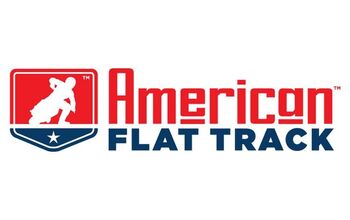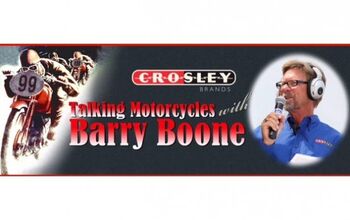American Flat Track Series: Interview With AMA Pro Racing CEO Michael Lock

The times they are a changing - and hopefully for the better
The 2017 season of the newly named American Flat Track racing series looks to be an exciting one. A slew of changes will roll out along with the new name. First, the premier class, GNC1, will no longer run Twins at big tracks and Singles at shorter ones, which formerly led to riders being sponsored by competing OEMs at the same time. Then there was the development class, the GNC2, that also had the same structural issues. Among the other changes, AMA Pro Racing CEO Michael Lock plans on implementing is a new elimination-style qualifying format that will have the big names out on the track in front of fans more times throughout the event.
At my recent day sampling the American Supercamp flat track training school, I was fortunate to spend some time talking with Lock about flat track’s past and his hopes for the future.
MO: You’ve got a big year ahead of you during the upcoming season with the changes in GNC1 and GNC2. What has been the feedback from the fans and racers. Do you feel the weight of history as you make this change?
Michael Lock: It’s interesting. Everybody says that until you actually look at the history, and then you realize [flat track] has endured because things have often changed and updated.
It’s really only a few years back that the concept of 450 production Singles was introduced. Prior to that there were 450s in custom-built frames, and they moved to a production-based motocross bike in order to open it up and to make it more accessible to new riders and make it more cost effective plus try to to attract the attention of other motorcycle manufacturers. I think this was about six or seven years ago, and it never really ignited. I think the idea was good, but the execution, perhaps, fell a little short.
Indian Scout FTR750 Ride Review
We looked at it and said, “What are the barriers to making a separation of Twins and Singles distinct classes? What are the barriers to that being a success? Is it that it’s a really bad idea?” No, it’s a really good idea. In any other form of motorcycle sport, the rider rides on that bike every week, and they become recognizable, and they get a fanbase. The OEMs look at it and say this is something they can support.
Why has this not worked? I looked into it coming from a non-flat track background, not afraid to ask the stupid questions, and said, “Hold on a second, guys. We’ve got these 450 Singles and we’ve got Twins, but they’re not two classes. They guys in GNC1 ride Twins and Singles, and whoops, the guys in GNC2 ride Twins and Singles. So, which is the premier class? Do I know what I’m watching? Do I know what the story is? No.”
We went back to it and said that the idea of having the two classes of hardware was a good idea, but it needs to follow through to be two distinct classes. The most experienced riders with the highest talent level are riding the most complex, fastest, and most difficult to control bikes, and the younger, less experienced riders with smaller budgets, who are on the early part of the learning curve, learn on the bikes that are easier to handle and are less intimidating. That sounds like simple logic.
That is what we developed. We tested it with our advisory group. We put feelers out there in the marketplace. We ironed the bugs out of it. For example, the sustainable objection for the Twins was that you can never race them on that tiny track at Daytona. It would be a mockery of the Twins and not make for good racing. It’s the [opening] curtain race of the season. You can’t do that.
We looked at it and said, “Yeah, you’re right. We can’t.” So, we’ve moved into the Speedway, and we’re building on the tri-oval, a TT which is a much grander vision than the short track was. [Note: TT moniker indicates turns in both directions and a jump will have been incorporated into track design for the Daytona TT.]
The other objection was on the Singles side, which was that these bikes were very closely balanced in terms of performance, which means that, on some circuits, they’d run as a very tight pack. People in the paddock said that they were concerned that Springfield, which is the fastest mile and the one where you’re on the gas for the most time, and what happens is the riders would bunch. These are the inexperienced riders would be at a high velocity, and they expressed that as a concern. We looked at it and said, “Yep, we agree. You’re absolutely right on that.”
So, for Springfield the two times a year that we go, we’re going to separate [the classes]. The Twins will race on the mile, and the Singles will race across the street on the short track the night before. We still have the integrity of the series. We’ll run both classes every week.
Having said all that, what you do get is in a storied sport, particularly one that’s been gradually shrinking every year. Is that people hold on to what they’ve got because they feel like something is being taken away from them, and any change is not considered an opportunity. It’s considered a threat. I get that’s a natural reaction, but we’ll get over that.
MO: It wasn’t just the Daytona Short Track that the Singles were being run at, though. How are you managing the Twins at those other venues?
ML: The Daytona Short Track was really an issue to run Twins at because the bikes are too big, too powerful, and too heavy.
MO: But you have other short tracks that you run on.
ML: We do, but not as short as that. That was the one that was identified by our community as the one that would be a bit of a waste of time to run the Twins on. It’s too short a short track. Historically, the Twins have run at short tracks. Just not as short as that.
MO: What do you see the five-year goal for expanding the series?
ML: We have a proposition. Our proposition is that pro flat track racing is a uniquely American sport. It was invented here. It’s developed here. The bikes are built here. The athletes are from here. It’s the only form of pro motorcycle racing that uniquely American.
It’s arguable that through the ‘70s, ‘80s, and the ‘90s, that [status] worked against it in an increasingly global pro sports world. MotoGP, World Superbike, Supercross, and Motocross completely dominated, and flat track fell off in popularity because it is parochial.
MO: Which is ironic because all of the major American GP champions of those decades came up through the flat track ranks.
ML: They did, but then they all went to MotoGP, which was global and paid more money and gave them different exposure. The two or three decades of shrinking in the sport were because the sport was considered parochial and didn’t scale. The irony is that, now we live in the digital age where you can find anything, anywhere, whenever you want, and actually, parochial has become cool. Because it’s different. It’s something you don’t see every other day.
We track the growth in interest, and it’s amazing that Facebook is the way that most people can access something. It’s easy to do, and you get a constant flow of information. We’ve seen our Facebook audience grow about 300% in two years, and the number-one country that followers have come from is Brazil. Number two is Thailand. Number three is the U.S. No European countries are in the top 10.
MO: Even with the Superprestigio?
ML: At first, we scratched our heads. Why is it that what we’ve got is not interesting to the developed markets. The countries where young people ride motorcycles – whether by choice or by necessity – means that they’re receptive to motorcycle sport, number one. Number two, most of the international pro motorcycle sport that’s available in those countries is locked down on pay-per-view or channels that you have to get special access for, the majority of which have a monthly cost. Thirdly, the countries that exhibited those two traits on the top of our list were ones with good wifi infrastructure.
We have Fan’s Choice TV, which means you can watch any of our pro races on your cell phone live wherever you are in the world. So, the accessibility though all this digital technology has created a whole new generation of fans. If I compare what we see in the grandstands at our races to what the demographic is in our digital, it’s like two universes. It’s really interesting.
We’ve got a great challenge to get people off their couch and come to a race and see it live – because life is busy and they can watch it any time online. The boomer generation still turns out for this stuff because they’ve been doing it for 40 years. Their kids and grandkids have got other things on their minds. Whereas with the international kids, we’ve got this huge following and this hunger for the sport.
In terms of how this means we develop things over five years, we’ve got to get people coming back to watch the races. Because the atmosphere when you’ve got 10,000 is totally different than when you’ve got 5,000, particularly if the grandstand was built for 12,000. We’ve got to do that. We’re innovating the event experience. The racing’s already pretty cool.
MO: The new qualifying structure change sounds like a good idea.
ML: It’s more intuitive for people. You’ve got a knockout tournament, and at the end, you get to see the 18 guys who earned their way there. Starting with a wide field and chopping it down makes sense to people. My personal impression of watching the racing this year and last year was: “So, those guys who are riding around at the back in the qualifiers who are obviously half a lap or a lap down of the winners, why am I watching them again? Why am I seeing them twice, but the good guys, I’m only seeing once?”
Jared Mees, who, as a fan, I want to see. As a promoter of the sport, I want to invest in the Mees and the Smiths and the Bakers. It seems counterintuitive that I see them in the shortest race of the evening, right at the start of the evening, and then they sit under their pop-up just to come out in the Main Event. That doesn’t seem equitable for the fan or the OEM or anybody. The only person it serves is the Jared Mees or Bryan Smith or Brad Baker who don’t want to have to go through all the elbows out to get to the finals. So, we changed the format to make it more intuitive and a bit more quick-fire.
We need to change the off-track stuff. The food catering needs to get better. The parking needs to get better. The what’s going on when there are no bikes on the track needs to get better. The communication to the fans, the addition of Jumbotrons, so when the announcer speaks to the fans about what going on, they can see a close up from the pits. We can treat if like more of a TV-like experience. That, I think, is going to be the key to getting new people to come to the sport. If they go to a rock concert or a baseball game or an NFL game, there’s a certain standard of catering for fan that you start to take for granted.
MO: The ticket prices for those events are significantly higher for those events than the typical flat track ticket, though.
ML: Ticket prices have got to represent a value for money. Most people I know would say, “Sure, I care about the ticket price, but frankly, my time is more valuable than the ticket.” If you said to me the ticket price is $75 or $35, I’d say what am I getting. I think, increasingly, that’s the question that people ask.
I’ve got two kids, I’ve got a 13 year old and an 11 year old, and I have taken them to a couple of races. If I were not involved in the sport, and I really wanted to go an see a flat track race because it was within an hour or so from home, and I took them to half the races that we put on, there is nothing to occupy my kids all day long there.
I think the overall fan experience has, maybe, been a little neglected the last 25 years. I don’t think it’s worse than it was; I just don’t think it’s better. In 25 years, those expectations change. You can’t say that you shouldn’t charge anybody more for the ticket because they won’t come and that $25 is really the ceiling. Which incidentally, is less than the cost of the round of drinks they bought on the way to the race for their three friends. The ticket price has to reflect the value of the day out, and the racing is awesome. To pay $25, $50, or $75 to watch an evening of racing is a great value for the money.
There are some things were doing in 2017 and some we’re doing in 2018. We are looking at a radio broadcast on an app, so that the commentary we’re putting together for the TV broadcast, the fans can listen to it in high quality. We’re looking at things like that. And online ticket sales that’s more than just buying a ticket, but it’s picking your seat in the grandstands and having information about local restaurants and hotels and all the kind of other information that the Trip Advisor generation takes for granted.

Like most of the best happenings in his life, Evans stumbled into his motojournalism career. While on his way to a planned life in academia, he applied for a job at a motorcycle magazine, thinking he’d get the opportunity to write some freelance articles. Instead, he was offered a full-time job in which he discovered he could actually get paid to ride other people’s motorcycles – and he’s never looked back. Over the 25 years he’s been in the motorcycle industry, Evans has written two books, 101 Sportbike Performance Projects and How to Modify Your Metric Cruiser, and has ridden just about every production motorcycle manufactured. Evans has a deep love of motorcycles and believes they are a force for good in the world.
More by Evans Brasfield











































Comments
Join the conversation
I love flatrack and they definitely went over the issues I see with it. In the stands at Mid 40's Im one of the kids compared to the rest of the crowd. This year Sac Mile and Hangtown MX was on the same day. I spent I think $30 for an all day event at Hangtown then cut the last race short to make it to Sac Mile, upper grandstand seat (so you can see the whole track as the only big screen was out of commission) $75 for roughly 3 hours. I spend $90 for 3 days at World Superbike, $100 when MotoGP was here.
MX - families, Kids all over, people of all ages
WSB - 20's on up
Flat track - 40 and up, half drunk to fully snockered.
1, well now 2, comments is telling. See you at Lima, Springfield, Dairyland Classic and CNY. But I'll be attending Octane and local events too. I have no interest in seeing twins at a TT. I'll start sending money to AIR and Class of 79 now.